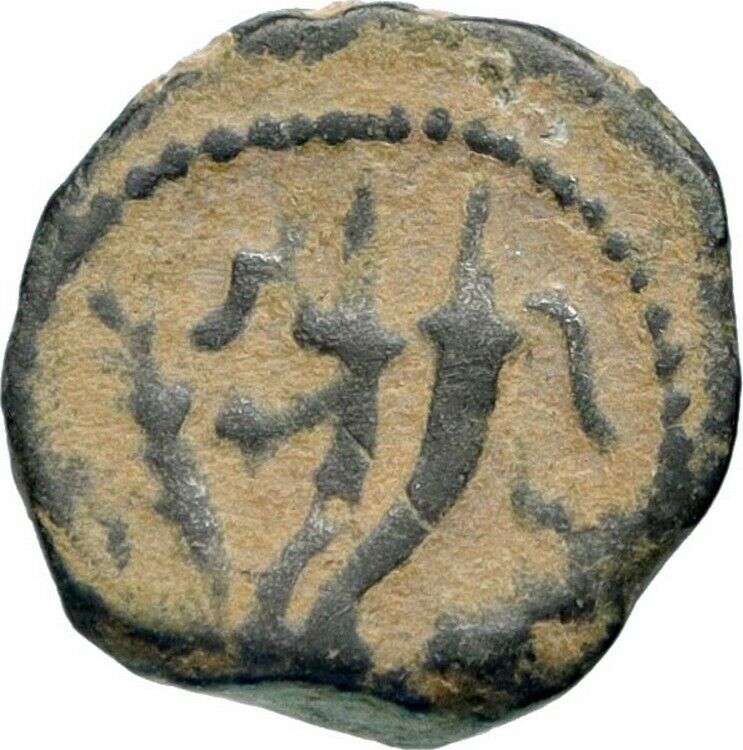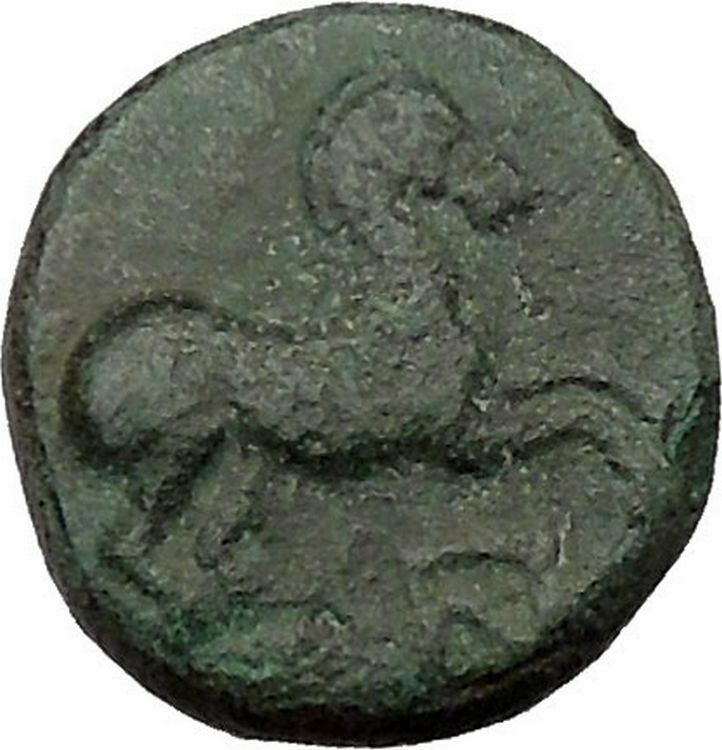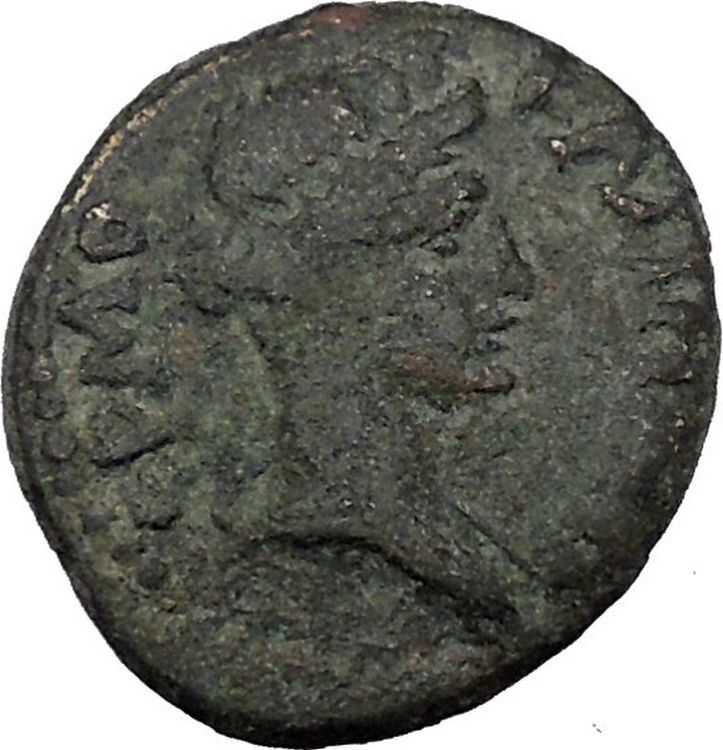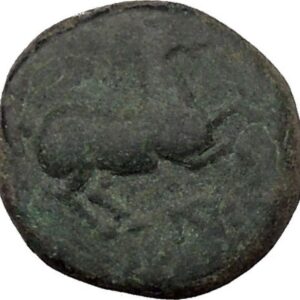|
Greek city of
Apameia
in
Phrygia
Bronze 22mm (6.32 grams) Struck 133-48 B.C.
Helmeted head of Athena right, in high-crested
Corinthian helmet and aegis..
AΠΑΜΕΩN,
eagle alighting right on basis decorated with meander
pattern, flanked by caps
of the Dioskouroi surmounted by
stars, magistrate’s name below.
<=”” p=”” align=”center”>
You
are bidding on the exact item pictured, provided with a
Certificate of Authenticity and Lifetime Guarantee of
Authenticity.
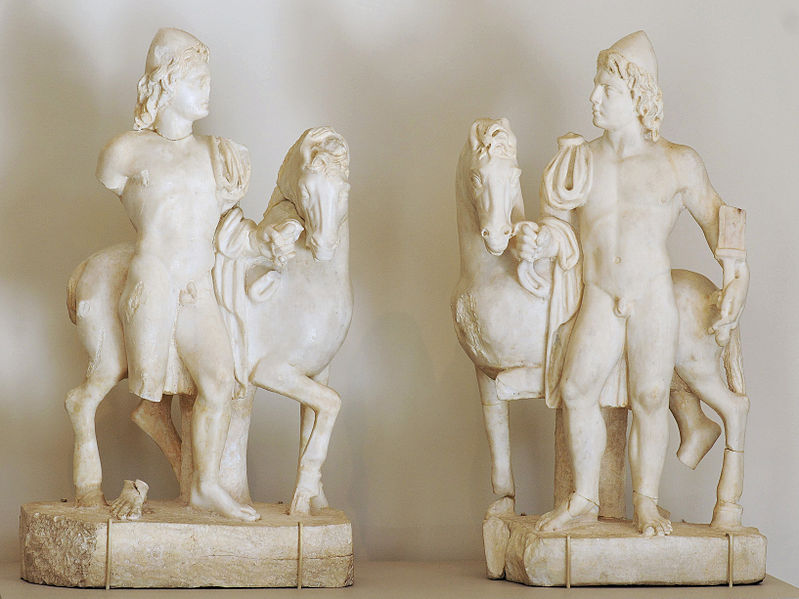
Castor and Pollux or Polydeuces
were twin brothers in
Greek
and
Roman mythology
and
collectively known as the
Dioskouroi
. They
were the sons of
Leda
by
Tyndareus
and
Zeus
respectively, the
brothers of
Helen of Troy
and
Clytemnestra
, and the
half-brothers of
Timandra
,
Phoebe
,
Heracles
, and
Philonoe
. They are
known collectively in Greek as the Dioscuri (Latin:
Dioscūrī;
Greek
:
Διόσκουροι,
Dioskouroi, “sons of Zeus”) and in Latin as the
Gemini (“twins”) or Castores. They are
sometimes also termed the Tyndaridae or
Tyndarids , later seen as a reference to their
father and stepfather
Tyndareus
.
In the myth the twins shared the same mother but had
different fathers which meant that Pollux was immortal
and Castor was mortal. When Castor died, Pollux asked
Zeus
to let him share
his own immortality with his twin to keep them together
and they were transformed into the
Gemini constellation
.
The pair were regarded as the patrons of sailors, to
whom they appeared as
St. Elmo’s fire
.

Rape of the Daughters of Leucippus by
Rubens, ca. 1618.
Apamea or Apameia (Greek:
Απάμεια) –
previously, Kibotos (Greek: κιβωτός), hê
Kibôtos or Cibotus – was an ancient city in
Phrygia
,
Anatolia
, founded by
Antiochus I Soter
(from whose mother, Apama, it
received its name), near, but on lower ground than,
Celaenae
(Kelainai).
//
Geography
It overlooks the
Ghab
valley and the site is now partly occupied by
the city of
Dinar
(sometimes locally known also as
Geyikler, “the gazelles,” perhaps from a tradition
of the Persian hunting-park, seen by
Xenophon
at Celaenae), which by 1911 was connected
with
İzmir
by railway; there are considerable remains,
including a theater and a great number of important
Graeco-Roman
inscriptions.
Strabo
(p. 577) says, that the town lies at the
source (ekbolais) of the
Marsyas
, and the river flows through the middle of
the city, having its origin in the city, and being
carried down to the suburbs with a violent and
precipitous current it joins the
Maeander
after the latter is joined by the
Orgas
(called the Catarrhactes by
Herodotus
, vii. 26).
History
The original inhabitants were residents of Celaenae
who were compelled by Antiochus I Soter to move farther
down the river, where they founded the city of Apamea (Strabo,
xii. 577).
Antiochus the Great
transplanted many
Jews
there. (Josephus, Ant. xii. 3, § 4). It
became a seat of
Seleucid
power, and a center of Graeco-Roman and
Graeco-Hebrew
civilization and commerce. There
Antiochus the Great
collected the army with which he
met the
Romans
at
Magnesia
, and two years later the
Treaty of Apamea
between Rome and the Seleucid realm
was signed there. After Antiochus’ departure for the
East, Apamea lapsed to the
Pergamene
kingdom and thence to Rome in 133 BCE, but
it was resold to
Mithridates V of Pontus
, who held it till 120 BCE.
After the
Mithridatic Wars
it became and remained a great
center for trade, largely carried on by resident
Italians
and by Jews. By order of Flaccus, a large
amount of Jewish money – nearly 45
kilograms
of gold – intended for the Temple in
Jerusalem was confiscated in Apamea in the year 62 BCE (Cicero,
Pro Flacco, ch. xxviii.). In 84 BCE
Sulla
made it the seat of a
conventus
, and it long claimed primacy among
Phrygian cities. When Strabo wrote, Apamea was a place
of great trade in the Roman
province of Asia
, next in importance to
Ephesus
. Its commerce was owing to its position on
the great road to
Cappadocia
, and it was also the center of other
roads. When Cicero was
proconsul
of
Cilicia
, 51 BCE, Apamea was within his jurisdiction
(ad Fam. xiii. 67), but the dioecesis, or
conventus, of Apamea was afterwards attached to Asia.
Pliny the Elder
enumerates six towns which belonged
to the conventus of Apamea, and he observes that there
were nine others of little note. The city minted its own
coins in antiquity. The name Cibotus appears on some
coins of Apamea, and it has been conjectured that it was
so called from the wealth that was collected in this
great emporium; for kibôtos in Greek is a chest or
coffer. Pliny (v. 29) says that it was first Celaenae,
then Cibotus, and then Apamea; which cannot be quite
correct, because Celaenae was a different place from
Apamea, though near it. But there may have been a place
on the site of Apamea, which was called Cibotus.
The country about Apamea has been shaken by
earthquakes, one of which is recorded as having happened
in the time of
Claudius
(Tacit.
Ann. xii. 58); and on this occasion the payment
of taxes to the Romans was remitted for five years.
Nicolaus of Damascus
(Athen. p. 332) records
a violent earthquake at Apamea at a previous date,
during the
Mithridatic Wars
: lakes appeared where none were
before, and rivers and springs; and many which existed
before disappeared. Strabo (p. 579) speaks of this great
catastrophe, and of other convulsions at an earlier
period.
Apamea continued to be a prosperous town under the
Roman Empire
. Its decline dates from the local
disorganization of the empire in the
3rd century
; and though a
bishopric
, it was not an important military or
commercial center in
Byzantine
times. The
Turks
took it first in 1070, and from the 13th
century onwards it was always in
Muslim
hands. For a long period it was one of the
greatest cities of
Asia Minor
, commanding the Maeander road; but when
the trade routes were diverted to
Constantinople
it rapidly declined, and its ruin was
completed by an earthquake.
Apamea
in Jewish tradition
Apamea is mentioned in the
Talmud
. The passages relating to witchcraft in
Apamea (Ber. 62a) and to a dream in Apamea (Niddah, 30b)
probably refer to the Apamea in Phrygia which was looked
upon as a fabulously distant habitation. Similarly the
much-discussed passage, Yeb. 115b, which treats of the
journey of the exilarch Isaac, should also be
interpreted to mean a journey from
Corduene
to Apamea in Phrygia; for if
Apamea in Mesene
were meant (Brüll’s Jahrb.
x. 145) it is quite impossible that the
Babylonians
should have had any difficulty in
identifying the body of such a distinguished personage.
Christian
Apamea
Apamea is enumerated by
Hierocles
among the
episcopal cities
of
Pisidia
, to which division it had been transferred.
The bishops of Apamea sat in the
Council of Nicaea
(325). Arundell contends that
Apamea, at an early period in the history of
Christianity
, had a church, and he confirms this
opinion by the fact of there being the ruins of a
Christian church there. It is probable enough that
Christianity was early established here, and even that
Saint Paul
visited the place, for he went throughout
Phrygia. But the mere circumstance of the remains of a
church at Apamea proves nothing as to the time when
Christianity was established there.
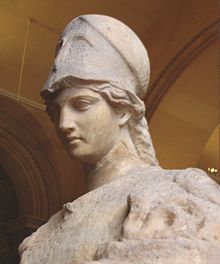
Helmeted Athena with the cista and
Erichthonius in his serpent form. Roman, first
century (Louvre
Museum)
In
Greek religion
and
mythology
, Athena
or Athene, also referred to as Pallas
Athena/Athene , is the goddess of wisdom, courage,
inspiration, civilization, law and justice, just
warfare, mathematics, strength, strategy, the arts,
crafts, and skill.
Minerva
is the
Roman goddess
identified with
Athena.
Athena is also a shrewd companion of
heroes
and is the
goddess
of heroic
endeavour. She is the
virgin
patroness of
Athens
. The Athenians
founded the
Parthenon
on the
Acropolis of her namesake city, Athens (Athena
Parthenos), in her honour.
Athena’s veneration as the patron of Athens seems to
have existed from the earliest times, and was so
persistent that archaic myths about her were recast to
adapt to cultural changes. In her role as a protector of
the city (polis),
many people throughout the Greek world worshiped Athena
as Athena Polias (Ἀθηνᾶ Πολιάς “Athena of the
city”). The city of
Athens
and the goddess
Athena essentially bear the same name, “Athenai” meaning
“[many] Athenas”.
Patroness
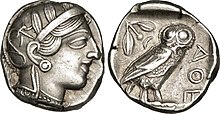
Athenian
tetradrachm
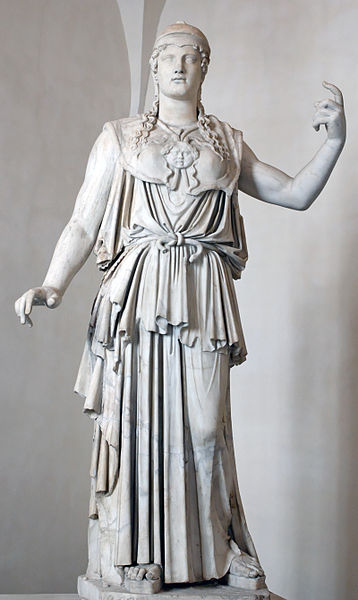
Athena
as the goddess of philosophy became an aspect of the
cult in Classical Greece during the late 5th century
B.C. She is the patroness of various crafts, especially
of
weaving
, as Athena
Ergane, and was honored as such at festivals such as
Chalceia
. The metalwork
of weapons also fell under her patronage. She led
battles (Athena
Promachos or the warrior maiden Athena
Parthenos) as the disciplined, strategic side of
war, in contrast to her brother
Ares
, the patron of
violence, bloodlust and slaughter—”the raw force of
war”. Athena’s wisdom includes the cunning intelligence
(metis) of such figures as
Odysseus
. Not only was
this version of Athena the opposite of Ares in combat,
it was also the polar opposite of the serene earth
goddess version of the deity, Athena Polias.
Athena appears in Greek mythology as the patron and
helper of many heroes, including
Odysseus
,
Jason
, and
Heracles
. In
Classical Greek
myths,
she never consorts with a lover, nor does she ever
marry,earning the title Athena Parthenos. A
remnant of archaic myth depicts her as the adoptive
mother of
Erechtheus
/Erichthonius
through the foiled rape by
Hephaestus
. Other
variants relate that Erichthonius, the serpent that
accompanied Athena, was born to
Gaia
: when the rape
failed, the semen landed on Gaia and impregnated her.
After Erechthonius was born, Gaia gave him to Athena.
Though Athena is a goddess of war strategy, she
disliked fighting without purpose and preferred to use
wisdom to settle predicaments.The goddess only
encouraged fighting for a reasonable cause or to resolve
conflict. As patron of Athens she fought in the Trojan
war on the side of the Achaeans.
Mythology
Lady
of Athens
Athena competed with
Poseidon
to be the
patron deity of Athens, which was yet unnamed, in a
version of one
founding myth
. They
agreed that each would give the Athenians one gift and
that the Athenians would choose the gift they preferred.
Poseidon struck the ground with his
trident
and a salt
water spring sprang up; this gave them a means of trade
and water—Athens at its height was a significant sea
power, defeating the
Persian
fleet at the
Battle of Salamis
—but
the water was salty and not very good for drinking.
Athena, however, offered them the first domesticated
olive tree
. The
Athenians (or their king,
Cecrops
) accepted the
olive tree and with it the patronage of Athena, for the
olive tree brought wood, oil, and food.
Robert Graves
was of
the opinion that “Poseidon’s attempts to take possession
of certain cities are political myths” which reflect the
conflict between matriarchal and patriarchal religions.
Other sites of cult
Athena also was the patron goddess of several other
Greek cities, notably Sparta, where the archaic cult of
Athena Alea
had its
sanctuaries in the surrounding villages of
Mantineia
and, notably,
Tegea
. In Sparta
itself, the temple of Athena Khalkíoikos (Athena
“of the Brazen House”, often
latinized
as
Chalcioecus) was the grandest and located on the
Spartan acropolis; presumably it had a roof of bronze.
The forecourt of the Brazen House was the place where
the most solemn religious functions in Sparta took
place.
Tegea was an important religious center of ancient
Greece, containing the Temple of
Athena Alea
. The
temenos was founded by
Aleus
,
Pausanias
was informed.
Votive bronzes at the site from the Geometric and
Archaic periods take the forms of horses and deer; there
are
sealstone
and
fibulae
. In the Archaic
period the nine villages that underlie Tegea banded
together in a
synoecism
to form one
city. Tegea was listed in
Homer
‘s
Catalogue of Ships
as
one of the cities that contributed ships and men for the
Achaean assault on Troy
.
Judgment of Paris

Aphrodite is being surveyed by Paris, while
Athena (the leftmost figure) and Hera stand
nearby.
El Juicio de Paris
by
Enrique Simonet
,
ca. 1904
All the gods and goddesses as well as various mortals
were invited to the marriage of
Peleus
and
Thetis
(the eventual
parents of
Achilles
). Only
Eris
, goddess of
discord, was not invited. She was annoyed at this, so
she arrived with a golden apple inscribed with the word
καλλίστῃ (kallistēi, “for the fairest”), which she threw
among the goddesses. Aphrodite, Hera, and Athena all
claimed to be the fairest, and thus the rightful owner
of the apple.
The goddesses chose to place the matter before Zeus,
who, not wanting to favor one of the goddesses, put the
choice into the hands of Paris, a
Trojan
prince. After
bathing in the spring of
Mount Ida
(where Troy
was situated), the goddesses appeared before Paris. The
goddesses undressed and presented themselves to Paris
naked, either at his request or for the sake of winning.

Paris is awarding the apple to Aphrodite,
while Athena makes a face. Urteil des
Paris by
Anton Raphael Mengs
,
ca. 1757
Still, Paris could not decide, as all three were
ideally beautiful, so they resorted to bribes. Hera
tried to bribe Paris with control over all
Asia
and
Europe
, while Athena
offered wisdom, fame and glory in battle, but Aphrodite
came forth and whispered to Paris that if he were to
choose her as the fairest he would have the most
beautiful mortal woman in the world as a wife, and he
accordingly chose her. This woman was
Helen
, who was,
unfortunately for Paris, already married to King
Menelaus
of
Sparta
. The other two
goddesses were enraged by this and through Helen’s
abduction by Paris they brought about the
Trojan War
.

The Parthenonn
,
Temple of Athena Parthenos
Masculinity and feminism
Athena had an “androgynous compromise” that allowed
her traits and what she stood for to be attributed to
male and female rulers alike over the course of history
(such as Marie de’ Medici, Anne of Austria, Christina of
Sweden, and Catherine the Great)
J.J. Bachofen advocated that Athena was originally a
maternal figure stable in her security and poise but was
caught up and perverted by a patriarchal society; this
was especially the case in Athens. The goddess adapted
but could very easily be seen as a god. He viewed it as
“motherless paternity in the place of fatherless
maternity” where once altered, Athena’s character was to
be crystallized as that of a patriarch.
Whereas Bachofen saw the switch to paternity on
Athena’s behalf as an increase of power, Freud on the
contrary perceived Athena as an “original mother goddess
divested of her power”. In this interpretation, Athena
was demoted to be only Zeus’s daughter, never allowed
the expression of motherhood. Still more different from
Bachofen’s perspective is the lack of role permanency in
Freud’s view: Freud held that time and differing
cultures would mold Athena to stand for what was
necessary to them.
|












